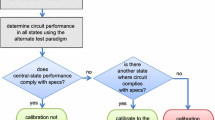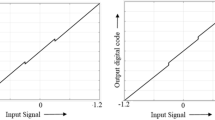Abstract
Modern mixed-signal/RF circuits with a digital calibration capability could achieve significant performance improvement through calibration. However, the calibration process often takes a long time—in the order of hundreds of milliseconds or even minutes. As testing such devices would require completion of the calibration process first, lengthy calibration would result in unacceptably long testing time. In this paper, we propose techniques to reduce the calibration time in a production testing environment, thereby reduce the overall testing time for the digitally-calibrated designs. In particular, we propose DfT modifications to accelerate the underlying adaptation algorithms and to terminate the calibration process as soon as it reaches convergence. We discuss the applicability of our techniques to general digitally-calibrated designs and illustrate the details using a case study of a digitally-calibrated pipelined ADC. Simulation results show that, for the target ADC, the proposed technique can achieve, on average, 99.5% reduction in the calibration time, which, in turn, results in a 75% reduction in production test time assuming a typical 300-millisecond testing time for testing the specifications of a calibrated ADC.












Similar content being viewed by others
Notes
The singularity problem states that, if a calibration stimulus is confined within a small region of a circuit’s input range, it may only activate a small portion of the circuit’s non-idealities. This will cause the adaptation algorithm to converge to a local optimum, which could be far away from the desired global optimum solution.
The effect of noise enhancement can be seen from Fig. 8. During the calibration process, the quantization error q is multiplied by a tap coefficient τ q that effectively amplifies the quantization noise. To compensate for the increased noise, additional sub-ADCs should be added to provide finer resolution. The last few LSBs may be discarded as the final output.
References
Chang H-M, Cheng K-T (2009) TAC: Testing time reduction for digitally-calibrated designs. In: Proc. of 15th IEEE international mixed-signals, sensors, and systems test workshop (IMS3TW), June 2009
Chang H-M, Lin M-S, Cheng K-T (2008) Digitally-assisted analog/RF testing for mixed-signal SoCs. In: Proc of Asian Test Symp (ATS), Nov. 2008
Chang H-M, Chen C-H, Lin K-Y, Cheng K-T (2009) Calibration and testing time reduction techniques for a digitally-calibrated pipelined ADC. In: Proc of VLSI Test Symp (VTS), May 2009
Chang H-M, Lin K-Y, Chen C-H, Cheng K-T (2009) A built-in self calibration scheme for pipelined ADCs. In: Proc of 10th Intl Symp Of Quality Electronics Design (ISQED), March 2009
Chiu Y (2008) Recent advances in digital-domain background calibration techniques for multistep analog-to-digital converters. In: Proc of 9th IEEE international conference on solid-state and integrated-circuit technology (ICSICT’08), Beijing, 2008
Chiu Y, Tsang CW, Nikolic B, Gray PR (2004) Least mean square adaptive digital background calibration of pipelined analog-to-digital converters. IEEE Trans Circuits Syst—I. Regular papers 51(1), January 2004
Defrêne K, Boos Z, Weigel R (2008) Digital adaptive IIP2 calibration scheme for CMOS downconversion mixers. IEEE J Solid-State Circuits 43(11):2434–2445
Deng J, Gudem PS, Larson LE, Kimball DF, Asbeck PM (2006) A SiGe PA with dual dynamic bias control and memoryless digital predistortion for WCDMA handset applications. IEEE J Solid-State Circuits (JSSC) 41(5):1210–1221
Der L, Razavi B (2003) A 2-GHz CMOS image-reject receiver with LMS calibration. IEEE J Solid-State Circuits 38(2):167–175
Harris RW, Chabries DM, Bishop FA (1986) A variable step (VS) adaptive algorithm. IEEE Trans Acoustics, Speech, and Signal Process ASSP-34(2), April 1986
Haykin S (2001) Adaptive filter theory, 4th edn. Prentice-Hall, NJ
Huang J-L, Ong C-K, Cheng K-T (2000) A BIST scheme for On-Chip ADC and DAC testing. In: Proc of design, automation and test in Europe (DATE), April 2000
Kim B, Fu Z, Abraham JA (2007) Transformer-coupled loopback test for differential mixed-signal specifications. In: Proc of VLSI Test Symp (VTS), May 2007
Kwong RH, Johnson EW (1992) A variable step size LMS algorithm. IEEE Trans Signal Process (40)7, July 1992
Liu H-C, Lee Z-M, Wu J-T (2005) A 15-b 40-MS/s CMOS pipelined analog-to-digital converter with digital background calibration. IEEE J Solid-State Circuits 40(5):1047–1056
Liu W, Chang Y, Hsien S-K, Chen B-W, Lee Y-P, Chen W-T, Yang T-Y, Ma G-K, Chiu Y (2009) A 600MS/s 30 mW 0.13 um CMOS ADC array achieving over 60 dB SFDR with adaptive digital equalization. In: IEEE international solid-state circuits conference, (ISSCC), San Francisco
Murmann B, Boser BE (2003) A 12-bit 75-MS/s pipelined ADC using open-Loop residue amplification. IEEE J Solid-State Circuits 38(12):2040–2050
Park J, Shin H, Abraham JA (2008) Parallel loopback test of mixed-signal circuits. In: Proc of VLSI Test Symp (VTS), May 2008
Staszewski RB, Wallberg J, Hung C-H, Feygin G, Entezari M, Leipold D (2006) LMS-based calibration of an RF digitally controlled oscillator for mobile phones. IEEE Trans Circuits and Systems—II Express Briefs 53(3):225–229
Tsang C, Chiu Y, Vanderhaegen J, Hoyos S, Chen C, Brodersen R, Nikolić B (2008) Background ADC calibration in digital domain. In: Proc IEEE custom integrated circuits conference (CICC), pp 301–304, Sept. 2008
Variyam PN, Cherubal S, Chatterjee A (2002) Prediction of analog performance parameters using fast transient testing. IEEE Trans Comput-Aided Des Integr Circuits Syst 20(3), March 2002
Voorakaranam R, Akbay SS, Bhattacharya S, Cherubal S, Chatterjee A (2007) Signature testing of analog and RF circuits: algorithms and methodology. IEEE Trans Circuits and Systems—I: Regular Paper 54(5), May 2007
Wang X, Hurst PJ, Lewis SH (2004) A 12-Bit 20-Msample/s pipelined analog-to-digital converter with nested digital background calibration. IEEE J of Solid-State Circuits 39(11), Nov. 2004
Wang P-Y, Zhan J-H, Chang H-H, Hsieh B-Y (2008) An analog enhanced all digital RF fractional-N PLL with self-calibrated capability. In: Proc IEEE custom integrated circuits conference (CICC), pp 749–752, Sept. 2008
Xing H, Jiang H, Chen D, Geiger R (2007) A fully digital-compatible BIST strategy for ADC linearity testing. In: Proc of IEEE international test conference (ITC)
Acknowledgements
This work is partially supported by the Gigascale Systems Research Center (GSRC), one of five research centers funded under the Focus Center Research Program, a Semiconductor Research Corporation program.
Author information
Authors and Affiliations
Corresponding author
Rights and permissions
About this article
Cite this article
Chang, HM.S., Lin, KY. & Cheng, KT.T. Calibration and Test Time Reduction Techniques for Digitally-Calibrated Designs: an ADC Case Study. J Electron Test 26, 59–71 (2010). https://doi.org/10.1007/s10836-009-5123-5
Received:
Accepted:
Published:
Issue Date:
DOI: https://doi.org/10.1007/s10836-009-5123-5




